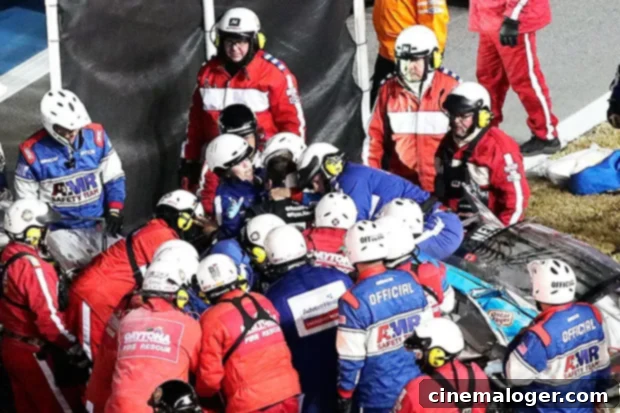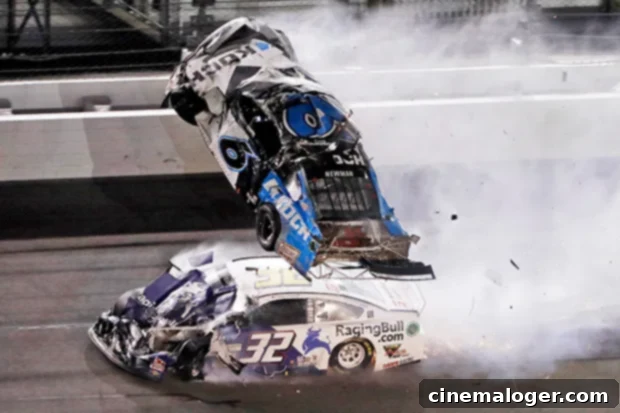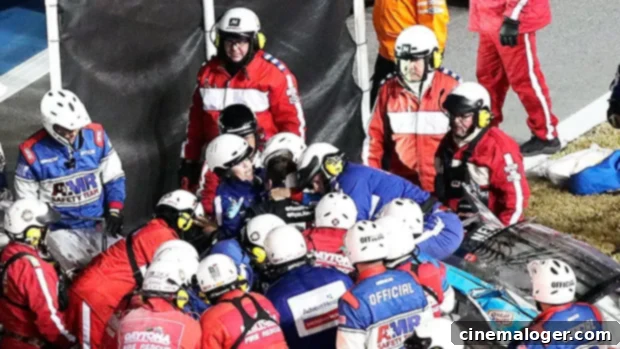Ryan Newman’s Miraculous Recovery: A Detailed Look at the Horrific Daytona 500 Crash and Its Aftermath
The world of NASCAR was gripped with fear and anticipation on February 17, 2020, as racing veteran Ryan Newman endured a terrifying, multi-car collision on the final lap of the iconic Daytona 500. The crash, which saw Newman’s car erupt in flames, go airborne, and ultimately skid to a halt in ruins, left fans and fellow competitors reeling. In the moments that followed, the sight of his team frantically working to extract him from the mangled wreckage became an enduring image of both terror and the profound courage inherent in motorsports. This incident not only highlighted the inherent dangers of professional racing but also underscored the remarkable advancements in driver safety that likely saved Newman’s life. What began as a desperate race to the finish line quickly transformed into a harrowing struggle for survival, culminating in a miraculous recovery that resonated deeply within the racing community and beyond.
The Harrowing Crash: Daytona 500’s Final Lap Fury
The 2020 Daytona 500 was reaching its crescendo, with the lead pack battling fiercely for supremacy as they entered the final lap. Ryan Newman, a seasoned competitor known for his aggressive racing style, was strategically positioned, contending for what would have been a monumental victory. As the cars roared around the track, the intensity was palpable. The incident unfolded with breathtaking speed, fundamentally altering the trajectory of the race and the fate of one of its most respected drivers.
The Critical Collision with Corey LaJoie
In a heart-stopping sequence, Ryan Newman’s No. 6 Ford Mustang made contact with Corey LaJoie’s No. 32 car. This initial bump, seemingly minor in the grand scheme of NASCAR racing, triggered a catastrophic chain reaction. Fox Sports broadcasters, narrating the live footage, captured the unfolding horror: “On the inside, they lock bumpers and it turns Ryan Newman around — upside down he goes.” The impact propelled Newman’s car directly into the SAFER barrier, then sent it airborne, spinning violently. The force of the collision was immense, causing his vehicle to flip onto its roof and slide into oncoming traffic. The chaotic scene was further exacerbated as other cars, unable to avoid the rapidly deteriorating situation, subsequently collided with Newman’s disabled vehicle. The sight of the car bursting into flames added another layer of terror, turning a competitive moment into a desperate emergency.
Immediate Aftermath and Rescue Efforts
The wreckage that remained of Newman’s car, once a meticulously engineered racing machine, was a stark testament to the ferocity of the crash. It was virtually unrecognizable, crumpled and torn apart. In the immediate moments after the catastrophic halt, the atmosphere at Daytona International Speedway was heavy with a chilling silence, soon replaced by the urgent sounds of emergency crews. Newman’s pit crew and safety personnel swarmed the vehicle, their every action dictated by the desperate need to reach their driver. The first images that surfaced captured this critical period: a blurred figure of Newman barely visible as his team, along with track safety officials, worked with incredible urgency and precision to extricate him from the crushed chassis. This painstaking process, complicated by the car’s severe damage, underscored the inherent risks these athletes face every time they strap into their machines.


Updates from Halifax Medical Center: A Journey Towards Recovery
Following his extraction, Ryan Newman was swiftly transported to Halifax Medical Center in Daytona Beach, Florida. The racing world collectively held its breath, awaiting news on the condition of the popular driver. The days that followed were a testament to the resilience of the human spirit and the effectiveness of modern medical care.
Initial Serious Condition, But Not Life-Threatening
NASCAR and Roush Fenway Racing wasted no time in releasing a joint statement, providing the first official update on Newman’s status. The initial report, though confirming a “serious condition,” offered a glimmer of hope: “doctors have indicated his injuries are not life threatening.” This crucial detail provided immense relief to fans, family, and fellow drivers who had witnessed the severity of the crash. The statement further conveyed appreciation for the outpouring of thoughts and prayers while respectfully requesting privacy for Ryan and his family during this challenging time. It was a period of intense medical scrutiny, as doctors diligently assessed the full extent of his injuries and initiated comprehensive treatment plans.
Awake and Speaking: A Significant Milestone (February 18, 2020)
Just one day after the horrifying incident, on February 18, 2020, at approximately 4:08 p.m. ET, a more reassuring update emerged. Roush Fenway Racing confirmed that Ryan Newman was “awake and speaking with family and doctors” at Halifax Medical Center. This was a monumental turning point, signaling a significant improvement in his condition. The ability to communicate, even if limited, was a powerful indication of his neurological status and the beginning of his active recovery process. The racing community breathed a collective sigh of relief, celebrating this crucial step forward. Ryan and his family, deeply moved by the overwhelming support, expressed their profound appreciation for the concern and heartfelt messages received from across the nation and the global NASCAR family. This update reinforced the strength of the bonds within motorsports, where rivalry on the track often gives way to profound solidarity in times of crisis.
Released from Hospital: A Miraculous Recovery (February 19, 2020)
In what many described as nothing short of miraculous, Ryan Newman was released from Halifax Medical Center on February 19, 2020, barely two days after the life-threatening crash. At 9:25 p.m. ET, the news broke that he had been “treated and released.” The sight of Newman walking out of the medical facility, flanked by his two daughters, was an incredibly powerful and emotional moment. The image, shared widely on social media, served as a potent symbol of hope and recovery. It transformed the initial fear and anxiety into profound gratitude and celebration. His ability to walk away from such a devastating accident, with what appeared to be a relatively swift recovery, was attributed not only to his physical strength and the expert medical care he received but also to the significant advancements in NASCAR safety technology. This rapid release allowed Newman to begin his recovery in the comfort of his home, surrounded by loved ones, a testament to the resilience of the human body and the efficacy of modern safety measures.
The Role of NASCAR Safety Innovations in Saving a Life
Ryan Newman’s survival and rapid recovery are powerful reminders of NASCAR’s relentless pursuit of driver safety. Over decades, the sport has continually evolved its safety protocols, vehicle design, and track infrastructure, often in direct response to severe accidents. The Daytona 500 crash served as a stark, yet ultimately positive, demonstration of these innovations.
How Modern Safety Features Mitigated Catastrophe
Key safety elements played a critical role in preserving Newman’s life. The HANS (Head and Neck Support) device, mandatory for all NASCAR drivers, significantly reduces the risk of basilar skull fractures and severe neck injuries during high-impact collisions. The design of the race car itself, particularly the advancements in crush zones and energy absorption, ensures that the forces of an impact are distributed away from the driver’s compartment. Moreover, the implementation of SAFER (Steel and Foam Energy Reduction) barriers along the outer walls of tracks like Daytona International Speedway is paramount. These barriers absorb kinetic energy upon impact, drastically reducing the G-forces experienced by drivers, thereby lessening the severity of injuries. While Newman’s car sustained catastrophic damage, the integrity of the driver’s cage, combined with these layered safety measures, created a survivable environment within the chaos. The quick response of the emergency medical teams, equipped with specialized tools and training for extricating drivers from such difficult situations, was also instrumental in his swift and successful rescue.
The Inherent Risks and Unwavering Spirit of Auto Racing
Despite these monumental safety strides, auto racing remains an inherently dangerous sport. The speeds involved, the close proximity of multiple competitors, and the unforgiving nature of the physics involved mean that accidents, when they occur, can be devastating. Ryan Newman’s crash was a stark reminder of these ever-present risks. Yet, it also showcased the unwavering spirit of the drivers who, fully aware of the dangers, continue to pursue their passion for speed and competition. Their bravery, combined with the dedicated efforts of engineers, medical professionals, and safety crews, continues to push the boundaries of what is possible in motorsports safety.
The Emotional Toll and Community Support
The impact of Ryan Newman’s crash extended far beyond the immediate incident, sending ripples of concern and support throughout the global racing community and beyond.
Reactions from Fans and Fellow Drivers
From the moment the crash occurred, social media platforms exploded with messages of concern, prayers, and well wishes for Newman. Fans, who had watched in horror, expressed their profound relief with each positive update. Fellow drivers, many of whom are close friends and competitors, were visibly shaken by the incident. Their reactions ranged from deep concern to heartfelt gratitude for Newman’s survival, emphasizing the close-knit nature of the NASCAR fraternity. Denny Hamlin, who ultimately won the race—his third overall and second in a row—admitted that the victory felt bittersweet, his mind preoccupied with Newman’s condition. The collective outpouring of positive energy and support served as a powerful testament to Newman’s standing in the sport and the compassion within the racing family.
Family Gratitude and Privacy
Throughout the ordeal, Ryan Newman’s family remained steadfast, balancing their private anguish with public expressions of gratitude. In their statements via Roush Fenway Racing, they consistently thanked the public for their “concern and heartfelt messages” and the “unwavering support of the NASCAR community and beyond.” This gratitude highlighted the comfort and strength they drew from knowing so many people were thinking of Ryan. At the same time, they respectfully requested privacy, allowing them to focus on Ryan’s recovery without undue intrusion. The balance between public transparency and personal space is often delicate during such high-profile medical emergencies, and the family navigated it with grace.
The Race Outcome and Denny Hamlin’s Victory
While the focus was overwhelmingly on Ryan Newman’s health, the Daytona 500 did conclude. Prior to the crash, Ryan Newman had been leading on the final lap, poised for a potential victory. His incredible drive positioned him firmly in contention, earning him the fourth-place slot despite the catastrophic finish. Ultimately, the title went to Denny Hamlin, securing his third Daytona 500 victory overall and an impressive second consecutive win. While a monumental achievement for Hamlin, the win was inevitably overshadowed by the anxiety surrounding Newman’s condition, demonstrating how quickly the focus of a major sporting event can shift from competition to compassion.
Looking Back and Moving Forward
The Ryan Newman crash at the 2020 Daytona 500 will forever be etched in NASCAR history as a moment of extreme peril and remarkable resilience. It underscored the inherent dangers of top-tier stock car racing while simultaneously celebrating the extraordinary effectiveness of modern safety protocols and the dedicated individuals who develop and implement them. Newman’s journey from the terrifying wreckage to walking out of the hospital in mere days is a powerful narrative of survival and recovery. It stands as a testament to his indomitable spirit, the skill of medical professionals, and NASCAR’s unwavering commitment to making a dangerous sport as safe as humanly possible. As the racing world continues to evolve, this incident serves as a poignant reminder of the constant balance between speed, competition, and the paramount importance of driver safety.
